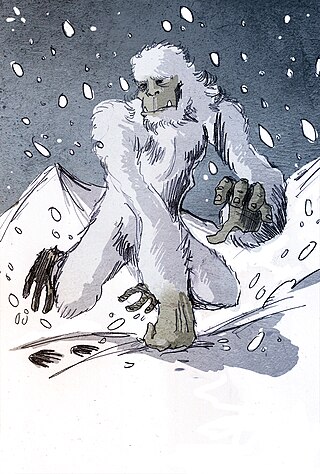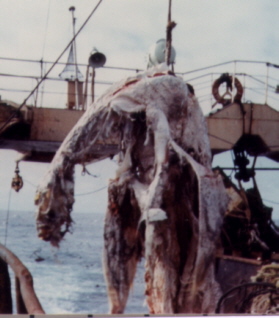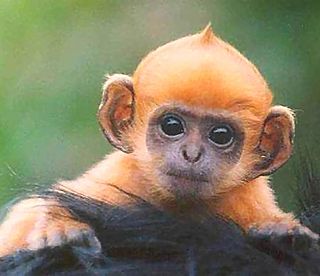
Bigfoot, also commonly referred to as Sasquatch, is a large and hairy human-like mythical creature purported to inhabit forests in North America, particularly in the Pacific Northwest.

The Loch Ness Monster, affectionately known as Nessie, is a creature in Scottish folklore that is said to inhabit Loch Ness in the Scottish Highlands. It is often described as large, long-necked, and with one or more humps protruding from the water. Popular interest and belief in the creature has varied since it was brought to worldwide attention in 1933. Evidence of its existence is anecdotal with a number of disputed photographs and sonar readings.

Mokele-mbembe, Lingala for "one who stops the flow of rivers", is a water-dwelling entity that supposedly lives in the Congo River Basin, sometimes described as a living creature, sometimes as a spirit. Descriptions vary widely among those who claim to have seen the creature, but it is often described as a large quadrupedal herbivore with smooth skin, a long neck and a single tooth or horn.

Primates are a diverse order of mammals. They are divided into the strepsirrhines, which include the lemurs, galagos, and lorisids, and the haplorhines, which include the tarsiers and the simians. Primates arose 85–55 million years ago first from small terrestrial mammals, which adapted to living in the trees of tropical forests: many primate characteristics represent adaptations to life in this challenging environment, including large brains, visual acuity, color vision, a shoulder girdle allowing a large degree of movement in the shoulder joint, and dextrous hands. Primates range in size from Madame Berthe's mouse lemur, which weighs 30 g (1 oz), to the eastern gorilla, weighing over 200 kg (440 lb). There are 376–524 species of living primates, depending on which classification is used. New primate species continue to be discovered: over 25 species were described in the 2000s, 36 in the 2010s, and three in the 2020s.

The Yeti is an ape-like creature purported to inhabit the Himalayan mountain range in Asia. In Western popular culture, the creature is commonly referred to as the Abominable Snowman. Many dubious articles have been offered in an attempt to prove the existence of the Yeti, including anecdotal visual sightings, disputed video recordings, photographs, and plaster casts of large footprints. Some of these are speculated or known to be hoaxes.

Friedrich Wilhelm Heinrich Alexander von Humboldt was a German polymath, geographer, naturalist, explorer, and proponent of Romantic philosophy and science. He was the younger brother of the Prussian minister, philosopher, and linguist Wilhelm von Humboldt (1767–1835). Humboldt's quantitative work on botanical geography laid the foundation for the field of biogeography, while his advocacy of long-term systematic geophysical measurement pioneered modern geomagnetic and meteorological monitoring.

A lake monster is a lake-dwelling entity in folklore. The most famous example is the Loch Ness Monster. Depictions of lake monsters are often similar to those of sea monsters.

New World monkeys are the five families of primates that are found in the tropical regions of Mexico, Central and South America: Callitrichidae, Cebidae, Aotidae, Pitheciidae, and Atelidae. The five families are ranked together as the Ceboidea, the only extant superfamily in the parvorder Platyrrhini.
The skunk ape is a cryptid ape-like creature alleged by cryptozoologists to inhabit forests and swamps in the southeastern United States. Perhaps most prominent in the state of Florida, the alleged creature is also commonly referred to as the Florida Bigfoot, and is often compared to, synonymous with, or called the "cousin" of Bigfoot, a prominent subject within North American popular culture.
The humanzee is a hypothetical hybrid of chimpanzee and human, thus a form of human–animal hybrid. Serious attempts to create such a hybrid were made by Soviet biologist Ilya Ivanovich Ivanov in the 1920s, and possibly by researchers in China in the 1960s, though neither succeeded. The portmanteau humanzee for a human–chimpanzee hybrid appears to have entered usage in the 1980s.

Louis François Fernand Hector de Loys (1892–1935) was a Swiss oil geologist. He is remembered today for the claim that he discovered a previously unknown primate, De Loys's ape, during a 1920 oil survey expedition in Venezuela. The identity of the animal he photographed has long been established with considerable confidence to be a spider monkey, and the identification as a new species is generally regarded as a hoax.

The Zuiyo-maru carcass was a corpse, most likely a basking shark, caught by the Japanese fishing trawler Zuiyō Maru (瑞洋丸) off the coast of New Zealand in 1977. The carcass's peculiar appearance led to speculation that it might be the remains of a sea serpent or prehistoric plesiosaur.

Yowie is one of several names for an Australian folklore entity that is reputed to live in the Outback. The creature has its roots in Aboriginal oral history. In parts of Queensland, they are known as quinkin, and as joogabinna, in parts of New South Wales they are called Ghindaring, jurrawarra, myngawin, puttikan, doolaga, gulaga and thoolagal. Other names include yaroma, noocoonah, wawee, pangkarlangu, jimbra and tjangara. Yowie-type creatures are common in Aboriginal Australian legends, particularly in the eastern Australian states.

Monkey is a common name that may refer to most mammals of the infraorder Simiiformes, also known as the simians. Traditionally, all animals in the group now known as simians are counted as monkeys except the apes, which constitutes an incomplete paraphyletic grouping; however, in the broader sense based on cladistics, apes (Hominoidea) are also included, making the terms monkeys and simians synonyms in regard to their scope.
Steller's sea ape is a purported marine mammal, observed by German zoologist Georg Steller on August 10, 1741, around the Shumagin Islands in Alaska. The animal was described as being around 1.5 m long; with a dog-like head; long drooping whiskers; an elongated but robust body; thick fur coat; no limbs; and tail fins much like a shark. He described the creature as being playful and inquisitive like a monkey. After observing it for two hours, he attempted to shoot and collect the creature, but missed, and the creature swam away.
Rolf Blomberg was a Swedish explorer, non-fiction writer, photographer and producer of documentary films.
BugGuide is a website and online community of naturalists, both amateur and professional, who share observations of arthropods such as insects, spiders, and other related creatures. The website consists of informational guide pages and many thousands of photographs of arthropods from the United States and Canada which are used for identification and research. The non-commercial site is hosted by the Iowa State University Department of Entomology. BugGuide was conceived by photographer Troy Bartlett in 2003 and since 2006 has been maintained by John VanDyk, an adjunct assistant professor of entomology and a senior systems analyst at Iowa State University. The website has been recognized for helping change public perception of insects.

Monkey meat is the flesh and other edible parts derived from monkeys, a kind of bushmeat. Human consumption of monkey meat has been historically recorded in numerous parts of the world, including multiple Asian and African nations. Monkey meat consumption has been reported in parts of Europe and the Americas as well.












